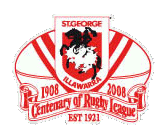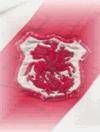 A
BRIEF HISTORY OF RUGBY LEAGUE
A
BRIEF HISTORY OF RUGBY LEAGUE
Football
has it's origins in antiquity when
village competition allowed players
to get the 'ball' through the opponent's
goal by running it, kicking it or
punching it. This evolved into a number
of sports including Association Football
('Soccer') where players were not
allowed to touch the ball with their
hands.
Regardless of its development, 'football'
retains the image of originally being
a game where running with the 'ball'
in hand was commonplace.
1823: According to the myth, American student William Webb Ellis runs with the ball in hand during a football match in Rugby Public School, England.
1872: Rugby Union rules were standardised with the first clubs being formed in France and England.
1892: The Rugby Union charges a number of working class clubs in the north of England with 'professionalism'. The dispute was over 'broken time' payments being made to players who lost wages for not being at work while playing football, or through injury sustained while playing football. The hard line line taken by the Rugby Union made it almost impossible for the working-class man to play the game, and this created a wedge between the north and south of England.
1895: The issue of compensation for lost work time led to a break-away movement. On August 27th or 29th, at an historic meeting at the George Hotel, Huddersfield the 'Northern Rugby Football Union' is formed. 'Coincidentially', England's Rugby Football Union creates the 1823 myth of William Webb Ellis, 72 years after event was supposed to have happened.
Delegates from nine Lancashire and 12 Yorkshire rugby union clubs met in Hudderfield and formally break away from the Rugby Union and form a new, independent body: the Northern Union.
The first
round of Rugby League matches was played
in Great Britain on September 7th, 1895.
The only media report was in the Pall
Mall Gazzette which stated "Professional
Rugby League set in on Saturday - no
deaths were reported".
The original
clubs and year of foundation (and formation
years as a rugby football club): Batley
1880, Bradford 1863, Brighouse Rangers
1878, Broughton Rangers 1877, Dewsbury
1875, Halifax 1873, Huddersfield 1864,
Hull 1865, Hunslet 1883, Leeds 1890,
Leigh 1877, Liversedge 1877, Manningham
1876, Oldham 1876, Rochdale Hornets
1871, St Helens 1874, Tyldesley 1879,
Wakefield Trinity 1873, Warrington 1875,
Widnes 1873, Wigan 1879.
Dewsbury withdrew a few days later and
were replaced by Runcorn (1876). Stockport
was also accepted by telephone at the
meeting at the George Hotel. The inaugural
competition which the 22 founding clubs
played for was called the Northern Union.
1897: The 'lineout' is abolished by the Northern Union. Goals were reduced to two points.
1898: The Northern Union legalises professionalism.
1906-7:
A number of rule changes were made.
Teams were reduced to 13 players a side
instead of 15.
1907-1908: A New Zealand team
tours Great Britain playing under Northern
Football Union rules.
On the 1st January, 1908, at Aberdare,
the first ever full Rugby League international
from a touring side takes place, Wales
versus New Zealand. Wales win the game
9-8 before a crowd of 17,000.
An Australian team tours
soon after playing three Tests 1908-1909.
The New South Wales Rugby League is
formed in Australia in 1908.
1922: The name 'Rugby League'
is adopted by the Northern Union.
RUGBY
LEAGUE IN AUSTRALIA
|
The
first Australian 'Rebels' game
of the breakway was played under
Union rules at Sydney's Agricultural
Ground on August 17th, 1907.
1908:
The first 'Rugby League' competition
is formed in Sydney and played
under the new Northern Rugby Football
Union rules. There is some debate
over which club was the first
to form with founding clubs Glebe
and Newtown both staking claims.
Recently discovered documents
support the Newtown RLFC claim.
On
the 27th September, the first
Kangaroos arrived in England,
and played their first ever Test
against Great Britain, (the GB
team was referred to as the 'Northern
Union', or 'England' until 1948)
in December in London. It finished
in a 22-22 draw. 1914: World War I. Rugby Union in Sydney is suspended for four years but Rugby League plays on. With only one major football code to watch, the popularity of Rugby League soars.
1954:
World Cup is instigated with
Australia, New Zealand, France
and Great Britain. The first Rugby
League World Cup took place in
France, in October and November.
The final, played at the Parc
des Princes packed with 30,000
fans, took place on 13th November,
where Great Britain defeated France
by 16-12. 1962: NSWRL re-introduced the allowance of two replacement players up to and including half time. Replacements were previously allowed up until 1923. 1967:
The most significant rule change
in the history of the game occurred
with the altering of the unlimited
tackle rule to a four tackle rule.
In 1971 (1972 in GB), this was
extended to six tackles.
Mid-1990s: The League's interpretation in regards to scrum play is altered to accomodate the modern game. By the mid-1990s, scrum penalties became a thing of the past with referees allowing the half back to feed the scrum in a manner which saw his team win the ball on almost every occasion. This led to a faster more free flowing game but made redundant the role of the hooker forward in scrum play. Another
major change was the extension
of replacements to an interchange
rule which allowed a limited number
of players to leave the field
and return thus creating a US
style 'bench' environment. During
the Super League conflict of 1996-97,
the interchange rule went unlimited. 1996:
'Super League' is formed as
a breakaway organisation in Australia.
With the advent of Super League,
the top tier of the game in Britain
moves from a traditional winter
to summer sport. 1998: Rugby League reforms under new name of National Rugby League (NRL). The ARL controls international fixtures. 1999: St.George & Illawarra becomes Rugby League's first successful joint venture. A new attendance world record of 107,999 is set at Stadium Australia for the 1999 NRL Grand Final on the 26th September 1999. The match won controversially by Melbourne Storm over the St George Illawarra Dragons 20-18. This
record crowd surpassing the Rugby
League 'double header' (featuring
Parramatta Eels v Dragons, won
20-10 by Parramatta) 104,583 set
at the same ground on the 6th
March 1999 during the launch of
the all new Stadium Australia. 2000:
Other clubs merge and by 2001
the 14 competing Clubs include:
St George-Illawarra Dragons, Newcastle
Knights, Sydney (formerly Eastern
Suburbs) Roosters, Melbourne Storm,
Brisbane Broncos, NZ (formerly
Auckland) Warriors, North Queensland
Cowboys, Wests Tigers (formerly
Western Suburbs and Balmain),
Northern Eagles (formerly North
Sydney and Manly), Canberra Raiders,
Parramatta Eels, Cronulla Sharks,
Penrith Panthers and the Bulldogs
(formerly Canterbury Bulldogs).
In
one of the biggest scandals in
the game's history, competition
leaders Canterbury Bulldogs have
been found to have breached the
salary cap by approximately $1MIL
over two seasons. The NRL fines
the Bulldogs and strips them of
all 37 competition points effectively
relegating them to last placed
wooden spooners for 2002. |
FIRST GRADE NSWRL / ARL /
SL / NRL CLUBS SINCE 1908
* In 1997 there were 2 competitions * denotes teams which competed in Super League. FIRST GRADE PREMIERSHIP RECORDS
Footnotes |






 1907:
Rugby Union was being played
in Australia and New Zealand for
time with similar debates was
over payment to players who were
injured or missing work due to
football commitments. Many wanted
to form a separate competition.
1907:
Rugby Union was being played
in Australia and New Zealand for
time with similar debates was
over payment to players who were
injured or missing work due to
football commitments. Many wanted
to form a separate competition.
 1922:
England drops the name 'Northern
Rugby Football Union' and adopts
the Australian name, 'Rugby Football
League'.
1922:
England drops the name 'Northern
Rugby Football Union' and adopts
the Australian name, 'Rugby Football
League'.
 1980:
The first 'State of Origin'
match is played between New South
Wales and Queensland. Previously, interstate
matches fielded players based
on the location of their current
clubs, usually giving NSW a decisive
advantage. The State of Origin
concept based selection of the
junior careers of players. In
front of estatic crowd at Brisbane's
Lang Park, Queensland won the
first State of Origin encounter
20-10. The significance of State
of Origin was typified by Queensland
captain, Arthur Beetson who although
a born and bred Queenslander,
played the majority of his adult
career for Sydney clubs.
1980:
The first 'State of Origin'
match is played between New South
Wales and Queensland. Previously, interstate
matches fielded players based
on the location of their current
clubs, usually giving NSW a decisive
advantage. The State of Origin
concept based selection of the
junior careers of players. In
front of estatic crowd at Brisbane's
Lang Park, Queensland won the
first State of Origin encounter
20-10. The significance of State
of Origin was typified by Queensland
captain, Arthur Beetson who although
a born and bred Queenslander,
played the majority of his adult
career for Sydney clubs.
 2002:
South Sydney Rabbitohs are
re-admitted in the NRL first grade
competition following a court
ruling the previous year. Souths
first match of the year, a pre-season
Charity Shield trial against St
George, attracts a crowd of 37,000
at the Sydney Football Stadium.
A record for a Rugby League pre-season
encounter. The match ended in
a 20-all draw.
2002:
South Sydney Rabbitohs are
re-admitted in the NRL first grade
competition following a court
ruling the previous year. Souths
first match of the year, a pre-season
Charity Shield trial against St
George, attracts a crowd of 37,000
at the Sydney Football Stadium.
A record for a Rugby League pre-season
encounter. The match ended in
a 20-all draw.